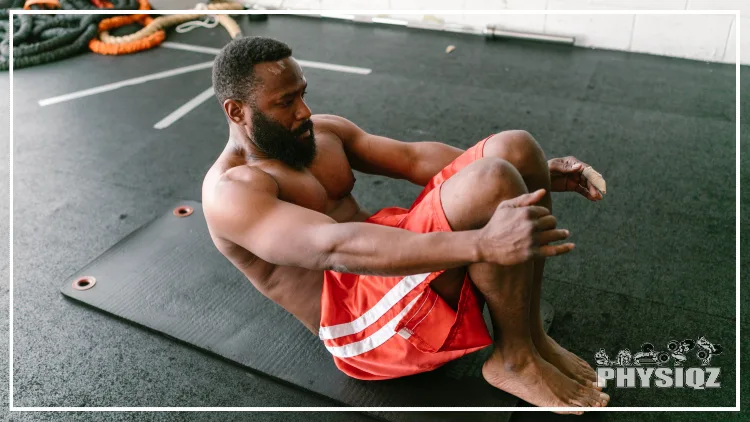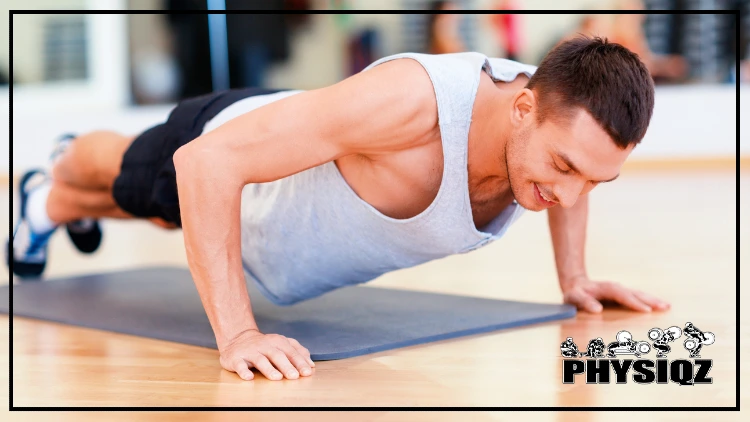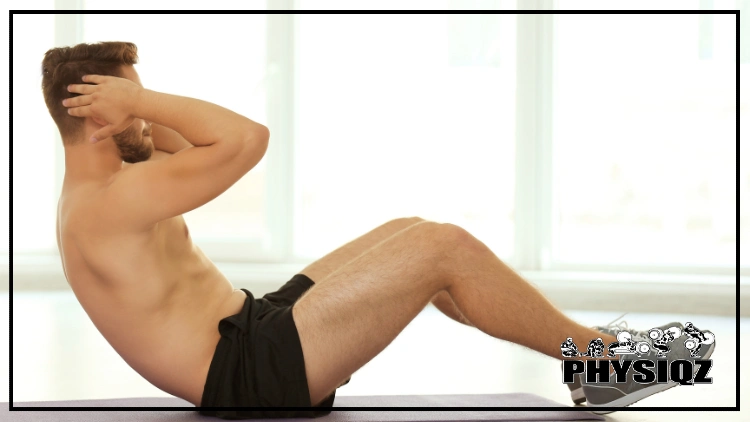
Push ups and sit ups are tried and true exercises that are used in a variety of workout programs, but the workout program below is designed specifically around these movements for people who don’t have equipment, don’t have a gym-membership just yet, or simply prefer to workout at home.1, 2
No matter the skill level, everyone can benefit from both sit ups and push ups and they’re a great way to start a fitness regimen too.
So before beginning, do yourself a favor by educating yourself on how many to do a day with my results taken into consideration, how to do both exercises with proper form, the easiest way to program these movements, and whether or not pushup or crunch challenges are even worthwhile.
Can Push Ups & Sit Ups Alone Be a Good Exercise Routine?
Sit ups and push ups are the staple of individuals trying to get into fitness, improving strength and building physiques and they can be used solely as exercises to achieve these objectives.
Both sit ups and push ups are a form of calisthenics exercises and they are a type of strength training that recruit large muscle groups using mostly body weight and can conveniently be done anywhere and at any time.3

Source: vansh mehta via Canva.com4
Push-ups focus on strengthening the chest, shoulders, triceps, core, and the serratus anterior muscle. On the other hand, sit-ups primarily work the core muscles, particularly the obliques and abdominal muscles—which are among the hardest muscles to develop.
Incorporating both these exercises into a routine will somewhat build strength and develop muscles if done with correct form. The two exercises are very much ideal for beginners since the potential risks that come with weighted strength training are mitigated.
The key with these exercises is to ensure that they are not overdone because it is quite easy to reach training plateaus after a while of doing them.
Training plateaus is a form of compensatory adaptive mechanism of the body as it becomes more efficient at performing a certain workout after a period of time—when this happens and the body no longer needs to make adaptations to the work placed on it, no more improvements are seen in both strength and muscle growth.5
There are ways around this such as using periodization which will be touched on in subsequent sections.
In addition, push ups target only the front of the body. When they are continually done, the front part of the body gets developed, while the back gets neglected. This will lead to muscle imbalances as the back will receive little stimulation. Too much pushing and little pulling which enlists the back muscles is additionally not good for the shoulder joint.
Including exercises that retract the scapular (shoulder blades) which is actually pulling the shoulder blades back will prevent slumped forward postures; it would therefore be a good idea to incorporate pulling exercises such as pull ups, machine rows, lat pull downs and exercises that target the rear of the shoulders like reverse flyes.
Push up and sit ups are both upper body exercises, it will also be beneficial to target the lower body and get those leg muscles firing. Just like these two exercises, no equipment is needed to do air squats and the body can get an all rounded balance workout that will induce better fat loss and build a better physique mimicking that of a bodybuilder.

Source: RODNAE Productions via Canva.com6
In fitness, the physique of a powerlifter differs from that of a bodybuilder. Powerlifters focus on three compound movements—deadlifts, squats, and bench presses—resulting in broader torsos. In contrast, bodybuilders often have defined abs from isolation exercises like sit-ups.
Pushups are a great compound movement and are often denoted as an almost perfect exercise and are a gauge to determine fitness levels so much so that the U.S military and other countries use them in determinations and training. Follow the program below and take advantage of what these two exercises have to offer in a way of benefits.
Is Doing 100 Push Ups & Curl Ups a Day Effective?
Doing sit ups and push ups are effective methods of increasing fitness and anyone looking to embark on the athleticism voyage. They can be done every day and still bring many benefits by enhancing fitness levels but may not be an option for those looking to pack on significant muscle mass. Muscles require progressive resistance—that is resistance that is constantly increased by loading more weight to achieve hypertrophy (muscle growth).
The only occurrence when doing curl ups and push ups everyday ceases to be effective is when the exercises have been loaded with weight and the use of resistance bands thereby creating conditions conducive for muscle growth through overloading. In this case, the muscles will need to recover and it would therefore be detrimental to do sit ups and push ups daily on these occasions.
The effectivity of doing 100 sit-ups and push-ups a day depends if they are loaded. In regards to doing them simply by body weight, then doing this many pushups which some would consider an extreme is acceptable and can give results especially for newbies.
A recent study had two sets of individuals doing push ups in one group and low load bench press in the other—both had similar size and strength and size increases in both chest and triceps, which substantiates that doing 100 push-ups and sit-ups daily for beginners is effective.7
How Often Should You Do Sit Ups & Push Ups (Frequency)
Just as it is important to do push ups and sit ups with correct form, it is equally important to do them with a frequency that ensures that there are progressive gains in strength and muscle—with that said, the number of times they do depend on the intensity of the workout.
If they are done with a high intensity that leads to muscle failure, then it is recommended to do these exercises up to 3 times a week. Otherwise, they may be done every day at low intensity.
In certain instances, doing push-ups daily could lead to overtraining, especially if experiencing delayed-onset muscle soreness (DOMS). In such cases, it’s wise to skip a day of workouts to allow the body to recover.
Delayed-onset muscle soreness (DOMS) is a state when the body receives a bout of intensive training leading the muscles to develop pain and tenderness due to muscle injury which is ultra-structural; this typically subsides after 48-72 hours.8 Continuing to exercise in this state is counterproductive and may increase the risk of injury.
How Many Pushups Should I Do in a Day?
There is no magical number as to how many pushups someone should do per day; however doing a minimum of 30 to 100 pushups is sufficient to draw some health benefits, maintain an ideal upper body physique and enhance fitness levels.
In fact, the higher the baseline pushup ability, the lower association risk with having cardiovascular (heart) problems.9 Therefore, everyone should strive to be able to perform as much as they can in a day.
How Many Sit Ups Should I Do in a Day?
Sit ups are great at burning fat and strengthening and increasing abdominal muscles—doing a minimum of 3 sets consisting of 10-30 reps per week would suffice. It should be noted that sit ups when done excessively may cause some people to experience lower back pain mostly due to bad form and also doing them excessively tends to tighten the hip flexor muscles.
These muscles then pull the lower back which causes the pain. Incidentally, sit ups engage the hip flexors more than they do the abdominals.
Push Up & Sit Up Workout Program: Intelligently Designed for Maximum Results
The military has incorporated pushups and sit up programs because of their effectiveness as the foundation of the tests they use to gauge the fitness levels of cadets. This involves high repetitions in both exercises with very little rest in 120 seconds and if they are good enough for them, then they can provide a viable platform for newbies wanting to get fit.
These programs are fast paced, allowing superior calorie burning, strength development in the chest, triceps, shoulders and developing the abs. Several beginners may not need to be able to perform push ups with their feet and may do so from the knees until they build enough strength.
These programs may be used to maximize pushups and sit ups and how many to do a day is key to seeing impressive results. To prevent hitting plateaus, variations will need to be made every 4 weeks to the frequency. Incorporating routines of daily undulating periodization into the regimen helps prevent plateaus by alternating between high-intensity and low-intensity workouts.
However, even by increasing volumes, plateaus can still be hit; therefore different variations can be done to the push ups like adjusting to wide stance push ups, increasing the time under tension by descending slowly or employing other core exercises with sit ups.
Workout Program #1
This workout begins with warming up with 10 jumping jacks and pushups and some light stretching on the shoulders, chest and triceps. The program should run for about 8 weeks.
Two rounds of the following are done back to back:
- 1 minute of push ups regardless of number.
- 1 minute of sit ups regardless of number.
Rest for one minute before moving to three rounds of:
- 30 seconds of pushups regardless of number.
- 30 seconds of sit ups regardless of number.
Proceed to rest for another 30 seconds and then finish off with the following:
- 15 seconds of pushups regardless of number.
- 15 seconds of sit ups regardless of number.
Workout Program #2
To begin this program, running and basic stretching can serve as the warm up. The pushup and sit ups are then done in a 15/15/5 format—15 pushups, 15 sit ups and 5 pull ups. This course lasts for 4 rounds and is done thrice a week. Once someone gets stronger, the reps can now be increased to a 20/20/5 format. This program should be done for 8 weeks.
Auxiliary Work
For those that are overachievers, or are simply seeking to take their fitness to the next level, should consider including lower body workouts that will allow them to engage the entire body—these include working the backs, calves and quads.
In fact, those seeking to massively build their core muscles which include the abdominal muscles have a better chance at doing so with full body workouts like the squat then isolated exercises such as sit ups that seek to target the abs.10
Starting with sit-ups and push-ups is an excellent way to get the body moving, aiding in building toned physiques and shedding fat. However, incorporating additional exercises like back squats, calf raises, single-leg deadlifts, single-arm dumbbell presses, and dumbbell thrusters can have a significant impact.
For these exercises, even using light dumbbells, kettlebells and weight plates can enhance the training.
How To Perform a Push-Up With a Proper Form
Before beginning a push up, it is important to ensure that the body is set up correctly. The hands should be placed at chest level slightly wider than shoulder width. The feet should not be turned inward or outward but rather parallel to each other and be about hip-width apart from each other. The lower back should be neutral in line with its natural curve and not too straight or curved and the hips should be aligned with the shoulders.

Source: Syda Productions via Canva.com11
With the head positioned in such a way that the ears are aligned with the ears, the core should be engaged, glutes squeezed, while ensuring pressure at the hands. Someone should then bend the elbow lowering the chest to the ground.
The chest should be lowered simultaneously with the hips and head. Reach as far down to the ground as is possible while still engaging glutes and core and maintaining pressure on the hands.
Push away from the ground with hands by activating the chest muscles keeping a focus on the energy as the target for energy and not the toes. Continue the push until the starting position while also engaging the triceps and repeat until failure.
How To Do a Sit-Up With Correct Technique
Sit ups are fairly simple to perform with correct form and they employ the abs and hip flexors to execute the movement. They are initiated by laying on the back or a bench and the feet are typically hooked down either with an object or a training partner. The hands may be placed either behind the neck or at the sides.

Source: pixelshot via Canva.com12
Raise the torso off the ground by bending hips and waist and lower the body back to the initial position and repeat until failure is reached.
How Long Does It Take To See Results From Sit-Ups & Push-Ups
To see effective results from doing sit-ups and push-ups demands that they are done consistently and with sufficient volume—when these two conditions are satisfied, then someone can expect to see some significant results after between 2-3 months of engaging in the routine. If the training volume isn’t adequate, individuals may find themselves getting stronger without gaining size.
6 Tips on How To Improve Push Ups & Curl Ups Results
There are a number of tips someone can incorporate into their push-ups and sit-ups regiment to enhance performance, increase fitness levels, increase strength, lose weight and even pack on some muscle. These factors involve integrating proper diet and nutrition, along with maintaining sufficient volume and form. The 6 tips are briefly outlined below:
#1 Adequate volume—the more push-ups and sit-ups someone does, the more likely they are to pack on muscle and increase strength. Increased training volume translates to greater muscle stimulation which leads to muscle growth.13
#2 Proper nutrition—ensuring a correct diet will go a long way in positioning the body to increase muscle mass and reduce fat which are goals of anyone on a training regimen. The diet should have increased protein content to allow for recovery, less carbs to promote fat burning and increased vitamins and minerals to maximize muscle growth.
#3 Correct form—doing push ups and curl ups with correct forms brings two main advantages; first, the body works efficiently to complete the movement which results in proper recruitment of the muscle groups leading to improvements in strength and mass and also reduces risk of injury that comes from bad form.
#4 Vary intensity techniques—eventually training plateaus will be hit as mentioned earlier. To avoid this, it is beneficial to vary intensity (load) of the workouts and not giving the body a chance to adapt to one training method and intensity.
#5 Movement type—varying the push ups and curl ups will also give the body different challenges and allow additional muscles to be recruited. For example, one may vary the hand width during pushups, or elevate their feet up and use resistance bands. For sit ups, someone may use a weight plate to add intensity.
#6 Include compound movements—including compound movements that work the whole body, that is adding the lower body will add variation to the push-ups and sit-ups routine and bring about balance. To enhance strength, build muscle, and accelerate fat burning, consider incorporating squats, calf raises, and deadlifts into your routine.
Including push ups and sit ups into a fitness enthusiast’s routine can confer health benefits, enhance strength and fitness levels while acting as a gateway to much more intense workout programs; the key is to remain consistent on how many to do a day with results that can show for it.
Frequently Asked Questions
Can Doing Sit Ups Build Abs?
Sit ups when done consistently and with enough volume can build abs. However, there are other options that are more effective and efficient at doing so such as bicycle crunches.
What Is The Difference Between Push Ups and Sit Ups?
Pushups are a compound movement recruiting several groups of muscles at the same time such as chest, triceps and shoulder muscles. Sit ups on the other hand, are an isolation movement targeting one group of muscles, in this case the abdominal muscles.
References
1Georgijevic. Canva. Accessed 15 April 2023. <https://www.canva.com/photos/MAEJfch1wEM-man-doing-push-ups/>
2Wavebreak. Canva. Accessed 15 April 2023. <https://www.canva.com/photos/MAEEhRlywcs-man-doing-sit-up/>
3Wikipedia. (2022, November 15). Calisthenics. Retrieved 2022, from <https://en.wikipedia.org/wiki/Calisthenics>
4mehta, vansh. Canva. Accessed 15 April 2023. <https://www.canva.com/photos/MAE1KSQcG1I-a-man-doing-push-ups/>
5Ram Gelman, M. B. (2022, February 2). A Subject-Tailored Variability-Based Platform for Overcoming the Plateau Effect in Sports Training: A Narrative Review. Retrieved 2022, from <https://www.ncbi.nlm.nih.gov/pmc/articles/PMC8834821/>
6RODNAE Productions. Canva. Accessed 15 April 2023. <https://www.canva.com/photos/MAEZjCrYWao-man-doing-sit-ups/>
7Naoki Kikuchia, K. N. (2017, June 29). Low-load bench press and push-up induce similar muscle hypertrophy and strength gain. Retrieved 2022, from <https://www.ncbi.nlm.nih.gov/pmc/articles/PMC5812864/>
8Karoline Cheung, P. H. (2003). Delayed onset muscle soreness : treatment strategies and performance factors. Retrieved 2022, from <https://pubmed.ncbi.nlm.nih.gov/12617692/>
9Justin Yang, C. A. (2019, February). Association Between Push-up Exercise Capacity and Future Cardiovascular Events Among Active Adult Men. Retrieved 2022, from <https://pubmed.ncbi.nlm.nih.gov/30768197/>
10Roland van den Tillaar, A. H. (2018, June 13). Comparison of Core Muscle Activation between a Prone Bridge and 6-RM Back Squats. Retrieved 2022, from <https://www.ncbi.nlm.nih.gov/pmc/articles/PMC6006542/>
11Syda Productions. Canva. Accessed 15 April 2023. <https://www.canva.com/photos/MAAwowGH4pA-smiling-man-doing-push-ups-in-the-gym/>
12pixelshot. Canva. Accessed 15 April 2023. <https://www.canva.com/photos/MAD-RNVJJrg-man-doing-sit-ups-indoors/>
13Gerald T Mangine, J. R. (2015, August 13). The effect of training volume and intensity on improvements in muscular strength and size in resistance-trained men. Retrieved 2022, from <https://www.ncbi.nlm.nih.gov/pmc/articles/PMC4562558/>